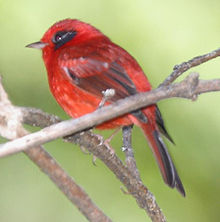Ergaticus
| Ergaticus | |
|---|---|

| |
| Red warbler | |
| Scientific classification | |
| Kingdom: | |
| Phylum: | Chordata |
| Class: | Aves |
| Order: | Passeriformes |
| Family: | Parulidae |
| Genus: | Ergaticus Baird, 1865
|
| Species | |
|
E. ruber | |
Ergaticus was a genus of
Both are average-sized warblers. Adult plumage is largely red, while juvenile plumage is largely "pinkish cinnamon-brown". The bill is small and narrow at the base even for a New World warbler. The tail is rounded and relatively long (Ridgway 1902). The songs consist of high-pitched chips and short trills (Howell and Webb 1995).
They live in forests at altitudes of 1,800 to 3,500 m (5,900 to 11,500 ft). They occur singly or in pairs and may join
The nest is shaped like an old-fashioned oven with an opening to the top or side, made of pine needles, grass, or similar materials. It is placed on the ground or on a bank. Both can lay 3 or 4 eggs; the pink-headed warbler sometimes lays only 2. The eggs are off-white with reddish-brown and gray speckles (Howell and Webb 1995).
Taxonomy
There are two sister species, separated by the low-lying Isthmus of Tehuantepec, in the genus. The red warbler, E. ruber, is found in the Mexican highlands north of the isthmus. Its three
Ergaticus is the Latinized version of the Ancient Greek ergatikos, meaning "willing or able to work".[6]
Species
| Image | Scientific name | Common Name | Distribution |
|---|---|---|---|
 |
Cardellina rubra | red warbler | highlands north of the Isthmus of Tehuantepec
|
 |
Cardellina versicolor | pink-headed warbler | south of the Isthmus, from the highlands of Chiapas, Mexico down into Guatemala. |
Description
These are medium-sized warblers, measuring 12.5–13.5 cm (4.9–5.3 in) in length,
Habitat and range
Both the pink-headed and red warblers are birds of highland forest.
Note
References
- ^ Baird, Spencer Fullerton (1865). Review of American Birds in the Museum of the Smithsonian Institution. Washington, D.C.: Smithsonian Institution. p. 264.
- ^ ISBN 1-112-57414-X.
- S2CID 86287753. Archived from the original(PDF) on 2011-06-29.
- ^ ISBN 0-19-854012-4.
- ^ ISBN 0-7136-3932-6.
- ISBN 0-398-00916-3.
- ISBN 0-19-857358-8.
